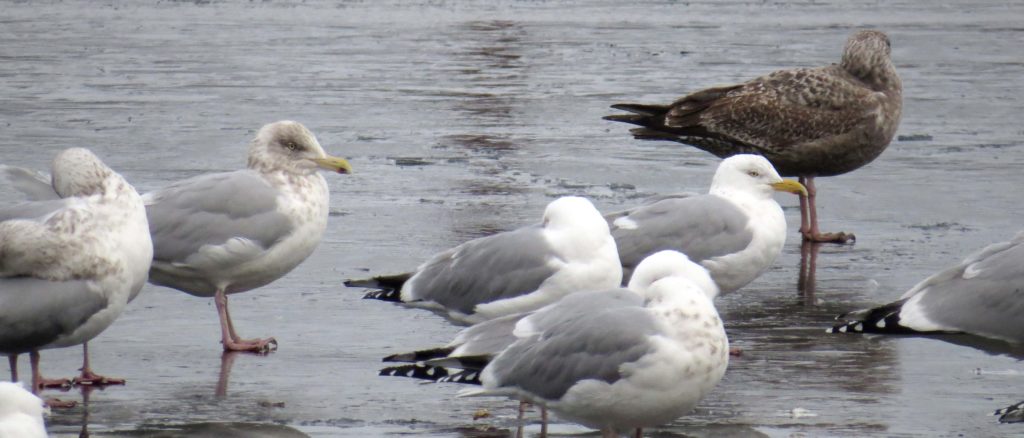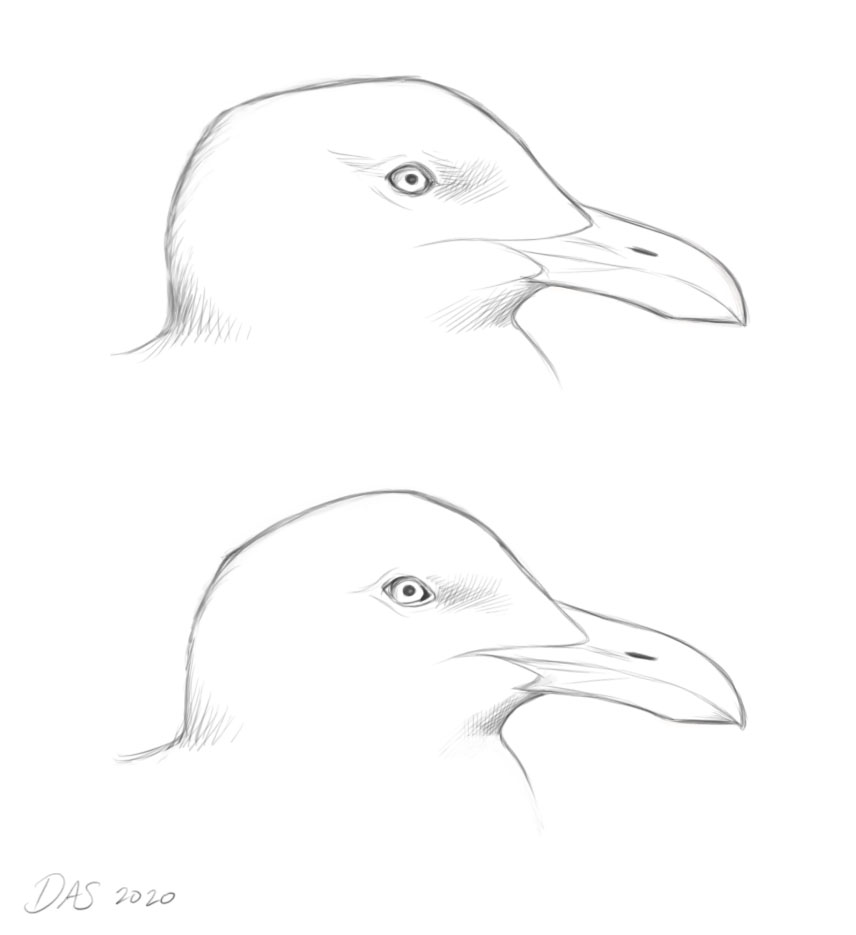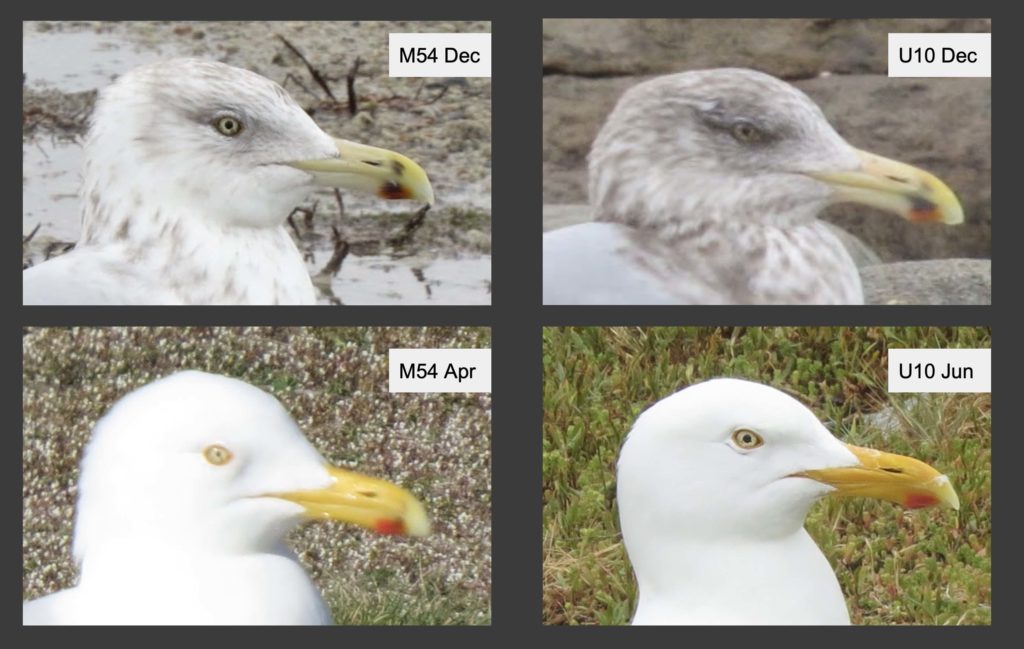I always enjoy studying Herring Gulls, just looking at variation and trying to categorize the birds into age, sex, and regional groups. Last winter I was watching the gull flock at Turners Falls, MA, paying special attention to when the adults molted into breeding plumage. My thought was that the early-molting birds would be from nearby breeding populations (more southerly so that they would be nesting earlier) and that late-molting birds were more likely to be migrants from the Arctic (nesting later).

The study
This line of investigation proved to be very interesting, as I immediately saw a pattern. Early molting birds with all-white heads in February seemed sleeker and smaller-headed, and gave a subtle impression of a smoother and rounder head profile, with a peak over the eye and a sloping rear crown. Birds that still retained nonbreeding head streaking appeared to show a more angular and more bulky head, with flatter crown and squared-off rear crown. This was the clue I had been hoping to find, and I thought it must indicate a difference between an early nesting population of round-headed birds and a later nesting population of square-headed birds.
Encouraged, I continued to study, looking for other differences that could help distinguish these two “populations”. Over the ensuing weeks, however, I made no headway. Worse, as all of the gulls molted to breeding plumage, I continued to see the same pattern. White-headed birds appeared to have smaller, more rounded heads than the streak-headed birds. I never found a white-headed bird that stood out by having a squared-off, “blocky” head.

The discovery
Gradually I came to suspect that an individual bird’s head shape might change as it molted to breeding plumage. This made some sense, as birds would need more insulation in winter and therefore might have more and longer feathers, which would produce a more bulky-looking head and neck.
It might have ended there, as an unverifiable hunch, except for the Appledore Island gull study and a dedicated photographer named Dave Adrien. For years, Herring Gulls in the Appledore Island colony have been marked with conspicuous leg bands, and Dave has been photographing these birds whenever he sees them, building up a valuable trove of photos of the same individual gulls at different ages and seasons. He was able to provide me with photos of several known individual Herring Gulls in both summer and winter. The head shapes in these photos match my impressions from the field, and reinforce my suspicion that head shape changes from summer to winter.

What does this mean for gull identification?
Head shape is often stressed as an important field mark for gull species. I generally downplay it, because it is so variable and there is lots of overlap between species, but I still look for it as an important component of the overall gestalt of a gull. Discovering that head shape varies seasonally might seem like a setback in the ongoing struggle to identify gulls, but it’s actually a step forward. It can help by refining our impressions of head shape and allowing us to categorize and explain some of the variation.
It also raises more questions: Is this a real difference? Is it produced by different lengths of head feathers and can that be measured? Do other species of gulls show similar variation? It also suggests that the head shape of immature gulls could differ from adults (I’ve long assumed that but never gave it serious study). Does the head shape of immature gulls vary seasonally like adults?
Thanks to Dave Adrien for taking the photos and allowing me to use them. And thanks to the Appledore Island Gull Research team for their work.


Thanks for this very insightful post, David. It would be interesting to look into this more with larger samples across various gull species. I’ve always thought head shape on alternate Herrings appeared sleeker and more compact, even rounder on both males and females. Now is a great time to observe this as some are completely white-headed and others are heavily streaked (like in your first image). It’s nice to see someone else has noticed it, and having banded birds throughout the seasons is a huge help. One point that I think is important to make is that these birds (both in basic and alternate head garb) are in a relaxed, natural posture? That is, the apparent head shape isn’t changing from one moment to the next depending on behavior or posture, right? I have an example of that here:
http://www.anythinglarus.com/2015/12/head-shape-on-large-white-headed-gulls.html
Hi Amar,
Thanks for your comments. I agree that head shape changes more with posture and “attitude” than any other factors, and I should have made that point in my post. Your photos illustrate that perfectly (thanks for the link!), and I know that the photos I used are not in matching poses. With the neck curled and the head lower on the shoulders that will tend to push the hindneck feathers up and produce a thicker neck and more square rear crown. If there is a real structural difference in the feathers between breeding and nonbreeding plumages, it will be hard to separate from all of the other variables. It’s even possible that birds in breeding plumage (in courtship mode) simply tend to hold themselves differently, maybe with the neck raised more, and this could lead to the impression of a rounder head. I also considered the idea that streaking could enhance the impression of a more “burly” head and neck, by emphasizing the contours more, while a clean white head simply looks smooth. In any case we all seem to agree so far that white-headed birds give a different impression of head shape. Now the challenge is to figure out why.
This reminds me of the change in head shape between alternate and basic plumage in Eared Grebe. I have no hard data but looking at transitioning birds suggests that the basic crown feathers are a different length than the alternate ones. This would be worth checking on gulls and could be studied easily enough on museum skins. Very cool observation!
Isn’t the change, in most species of gull, from non-breeding/basic plumage to breeding/alternate plumage down to wear and thus by dint of that wear, the feathers will be shorter/
Thanks for posting such an informative article. Some articles are written in such a manner that people read like a story. But your article is like a scientific research and it really need a deep concentration to read it. Thanks again and hope to get such article in future also. I am a bird watcher and bird photographer. I write a blog on identification of Indian Birds. Name of my blog is Birds of India. Please visit my blog and give your valuable feedback.
We have had a pair of Herring gulls in our garden on the shed roof for many years. We do not actually feed them but they come down and take the bird food we put out for the garden birds. We have noticed this year that their usually spotless white heads have turned streaky grey as your top photo on the left. Is this some sort of winter coat change or have they murdered our usual pair and stole their identity lol. Would be interested on your thoughts. We are on the south east coast of the UK.